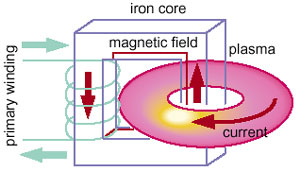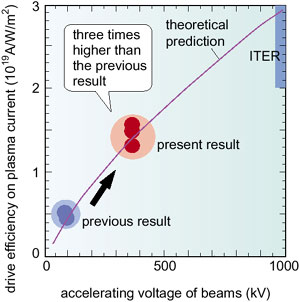The beam current drive is a method of generating plasma currents by externally injecting high-energy particle beams into plasmas, through the energy transfer from beam to plasma ions (Fig. 3-1). The beam current drive is a promising technique for the production of plasma currents in tokamak fusion devices without use of the inductive technique (Fig. 3-2), and then is one of the most important issues for steady-state operation of tokamak fusion reactor.
In JT-60, a negative-ion-based neutral beam injector which was the first developed in the world to obtain high-energy powerful beams and a beam current drive of 1 MA class, has been successfully demonstrated for plasmas with high temperature (108 degrees cent.) and high density (5 x 1019/m3). Comparisons between experiments and theoretical predictions have been also in progress. Figure 3-3 shows the current drive efficiency plotted against the accelerating voltage of the injector. The measured efficiency increased with the accelerating voltage according to the theoretical prediction. At an accelerating voltage of 360 kV, the efficiency reached a world record 1. 6 x 1019 A/W/m2, which was three times higher than the previous data at 100 kV. A beam current drive device for ITER (International Thermonuclear Experimental Reactor) is required to operate at 1 MV with an efficiency of 2 x 1019 A/W/m2. Results shown in Fig. 3-3 give us the expectation of realizing a current drive efficiency as high as that required in ITER. |



